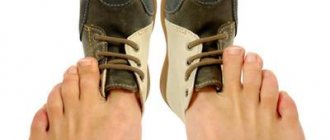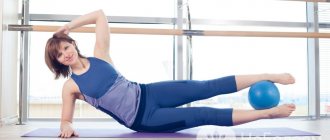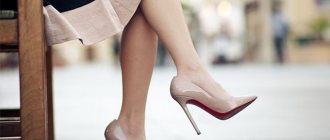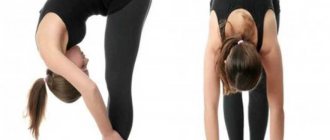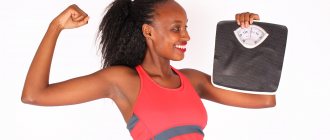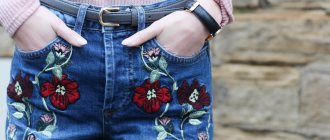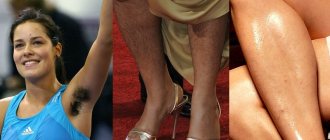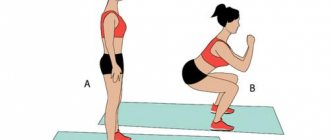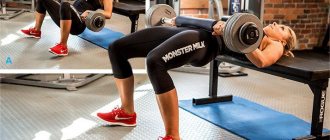Most modern amateur athletes do not pay special attention to an additional set of exercises due to lack of time, reluctance, or simply lack of necessary knowledge. However, professional athletes spend enough time to properly enter the training process. Such methods include many different pulling exercises, including hip stretches .
Stretching is a specialized training complex, the main goal of which is to improve the flexibility of muscle tissue and joint mobility.
There are several types of techniques:
- static – characterized by bringing muscle tissue to a certain position, stretching it and fixing it in this position;
- PNF stretching – in which you perform compression and stretching yourself;
- passive view - with the help of a partner;
- active type - work without additional assistance;
- techniques of a ballistic nature - peculiar bouncing is used, which causes more significant tension;
- dynamic techniques - using muscle stretching using controlled movements, with increasing speed.
Important! In the initial stages, it is recommended to use exclusively static stretching techniques to avoid various injuries and damage.
Front thigh stretch
A flexible, elastic body is a person’s dream.
It is possible to try to achieve your plans. The right set of exercises performed daily will help you achieve your cherished goal. The front surface of the thigh is a tender part; you need to stretch it carefully. The area is pumped at an accelerated pace, becomes very noticeable, “swollen”, to prevent this, you will need to give up excessive weights when working with the front surface of the thigh. The muscles of the legs are pumped much less often than other parts of the body.
Anatomy of the anterior thigh
The muscles of this part allow you to bend your knees, tilt your pelvis forward, bend your hips, and the posterior muscles help you straighten.
On the front of the thigh is the most powerful muscle of the legs - the quadriceps or quadriceps muscle - so named due to the heads of the muscle, which begin from the femur and end in the tibia, forming a common tendon. An exception is the rectus muscle, which descends from the ilium and attaches to the acetabulum. The quadriceps helps the knee joint to fully extend.
The structure of the quadriceps includes muscles:
- The rectus muscle turns out to be the longest of the other four heads of the anterior leg muscle. It is located from the acetabulum and ends near the tibial tubercle. Non-flexion of the knee has the least impact.
- The vastus lateralis is the largest muscle in this part of the thigh. The shape is flat, wide and thick. Descends from the trochanter of the femur, weaving itself to the bottom of the tendon of the rectus leg muscle.
- Medial wide - shaped like a drop located inside, originating from the linea aspera and moving to the patellar ligament.
- Intermediate wide - lies between the medial and lateral, is located deeper than the others, and is recognized as weaker than the others.
Stretching flexor muscles
This is an effective beginner's exercise that can be done at home; this stretch is usually used on the muscles of the front of the thigh, including the rectus femoris.
- Kneel on one leg. The other leg should be in front with the knee bent.
- Shift your weight to the front of your body.
- Tighten your hips during the exercise for 10-30 seconds.
Muscles involved: Rectus femoris. Iliopsoas muscle.
Stretching the muscles of the front of the thigh: general rules
Any stretching of the rear and anterior muscles requires compliance with the rules, first of all, so as not to damage your health, and secondly, so that the achieved result is maintained for a long time.
Classes are conducted systematically. The number of classes should not decrease.
You will need to learn how to properly relax your leg muscles, otherwise you may end up with chronic fatigue syndrome.
Before stretching the thigh muscles, it is recommended to warm up, otherwise you may end up with an injury. Exercises that are often suggested as stretching include rotation of the pelvis and ankle joint of the legs.
Consider going for a run as a great way to exercise. You need to run at a normal pace, jumping from foot to foot with swinging movements. You can warm up by jumping in place, on one leg or both.
Warming up the leg muscles before stretching will prepare the ligaments for the exercise.
The minimum time spent in a stretching pose is 10 seconds, gradually increase to 60. Stretching for less time will not give results.
To achieve success when stretching, you need to breathe deeply. You can't hold your breath!
Remember, muscle stretching is not supposed to be painful. Some discomfort is acceptable, especially in the initial stages, but not pain.
To harmoniously stretch your thigh muscles, it is recommended to create a muscle stretching program.
Good muscle stretching is the result of many years of work on the body. You will need to have a considerable amount of patience to engage in this type of activity.
The benefits of exercise are obvious: the effects of stress are prevented, weight is normalized, the cardiovascular system begins to function normally, and the body’s overall resistance is developed.
Training is gradually becoming a part of life. Stimulate your own interest by doing family or group activities.
Stretching while standing on one leg
To perform this type of stretching you will need:
- Stand up straight.
- The right leg stands on a support - any surface above the level of the pelvic bone.
During the exercise, the back and gluteal muscles are strongly worked out in a comprehensive manner, the muscles of the lower leg, the back and front muscles of the thigh are stretched.
- To achieve maximum stretching, try to keep your back straight during the exercise, make sure that your legs do not bend, and your pelvic bone does not lean forward.
- If you choose a higher support, the stretching of the muscle group in question will significantly increase. You will also be able to feel the stretching of individual back and front muscles on your left leg.
The classic version of stretching the anterior thigh muscles is done while standing:
- Stand on one leg. It is recommended to hold on to a chair, a wall, or to raise the limb perpendicular to the floor, however, when performing the exercise for the first time, there is a risk of falling.
When performing the exercise, you will need to straighten your chest, shoulders and align your body parts.
Lunge Stretch
- Take the appropriate position in which the left leg takes a forward position.
- Bend your left leg at a right angle. The knee and ankle joints conditionally create a straight line.
- To balance your torso during the exercise, you need to grab a support (for example, a chair) or your left knee.
- The pelvic bone moves forward so that the knee moves further than the ankle joint; the heel cannot be lifted off the floor.
The exercise will allow you to work the anterior gluteal and individual posterior and anterior femoral muscles of the legs, lower leg, and lumbar region.
During the exercise, movements should be done smoothly, without jerking or sudden movements! Make sure that your left knee remains pointed forward and your right knee is off the floor.
If you want to stretch further, when your pelvis reaches the front point, you should arch your back.
Stretching while lying down
The exercise is performed according to the algorithm:
- Lie on your right side.
- Bend your left leg as much as possible, bring your heel to your buttocks a short distance.
- Take the foot, pull it closer to the buttocks, while simultaneously moving the pelvis forward. Don't try to touch your heel to your buttocks. As in the previous exercise, be careful. Pull the foot slowly to avoid injury to muscles and joints. During the exercise, focus on stretching the back and front muscles of the thigh, not on bending your leg to the maximum.
Thanks to the exercise, the gluteal, lumbar and femoral muscles of the legs are stretched.
Piriformis muscle - stretching
The piriformis muscle can be very troublesome and cause sciatica symptoms, including leg pain. Training this muscle, especially in combination with other exercises, will maintain its elasticity and prevent damage to the sciatic nerve.
- Lie with your shoulder blades on the floor.
- Bend your right leg and cross the ankle of your left leg over your right leg.
- Cross your leg over your upper thigh.
- Pull your leg as close to you as possible to increase the pressure.
- The exercise time is 10-30 seconds.
Muscles involved: Piriformis.
Leg stretching exercises, or Magic stretching
Each of us secretly or openly dreams of the ideal shape of our legs. And we want our legs to be not just slender, but also toned, strong, and also “sculpted.” For some, a dream remains a dream, while others begin to go straight towards this dream. That’s why they exhaust themselves with all sorts of diets and long workouts in gyms or start running in the morning.
The result, as a rule, does not take long to wait - your legs become slimmer. But for some reason the lightness in my legs does not increase. Did you know that leg stretching exercises will help you not only gain ease of gait, but also restore elasticity to the muscles, and therefore add elasticity and sculpturalness to your legs? If you decide to lose weight, then stretching should become an indispensable component of the whole process.
Any set of workouts in a fitness center necessarily includes stretching. However, you can stretch your legs with benefits for beauty and health at home. To do this, it is not at all necessary to adhere to any specific training program. You can choose a set of exercises that will bring both benefits and pleasure. Yes, yes, stretching is one of the few types of gymnastics that is actually pleasant to do. We offer you just such a complex that you can add to your regular morning exercises, or perform these exercises at home (even while lying on the couch) at any convenient time.
Stretch the inner thigh
- This is exactly the exercise you can do while lying on the couch. But it’s better to lie on the floor face up, and raise your legs at right angles to your body. To maintain this angle and not “drop” your legs, lie with your butt against the wall (at a distance of fifteen centimeters) and keep your legs parallel to the wall. So, starting position: lying on your back, legs up (legs and back straight). Start spreading your legs to the sides until you feel discomfort at first. Hold for thirty seconds and return to the starting position. Open your legs again, hold for half a minute and bring your legs together. Perform at least ten approaches in one session.
Gradually (day by day) increase the width of your leg spread. But don’t try to push them as wide as possible right away. Stretching exercises should be performed smoothly and the load should be increased gradually. Any unpleasant sensations during stretching are simply unacceptable. And the main secret is holding in the position of maximally (but pleasantly!) stretched muscles and subsequent relaxation.
- Sit on the floor with your feet together and your knees out to the sides. Pull your stomach in and begin to slowly lean forward until you feel a stretch in the muscles of your inner thigh. Stay in this position for thirty seconds and relax. Perform at least ten inclines in one session.
Back stretching exercises
Stand next to a rack, exercise machine or other support, turn your left shoulder towards it. With your right hand, grab the rack high above your head and move your pelvis to the right and down, stretching the entire right side of your body.
Sit on the floor, move your right leg forward, left leg back. Bend your knees at an angle of 90 degrees or slightly more. Place your right hand on the floor, raise your left above your head. Pull your left leg down and back, tilt your body forward and twist towards your right leg.
Switch legs.
Sit on the floor, bend your knees and place your feet on the floor. Grasp your shins with your hands on the inside, place your wrists on your feet. Bend forward with a round back as low as possible.
Child's pose
Sit on the floor, buttocks should touch your heels. Lean forward, lie on your stomach on your knees and extend your arms.
Get on all fours, then move your pelvis back and up so that your body resembles an angle. Your arms and back should be stretched out in one line, your knees can be bent, and your heels can be lifted off the floor. The main thing is that your back remains straight, without rounding in the lower back.
Grab a low horizontal bar and hang freely, relaxing your body. Feet should remain on the ground. Relax them, bend your knees slightly.
Lie on the floor on your back, arms along your body, legs straight. Raise your legs and then throw them behind your head. Hands rest with elbows on the floor, hands support the lower back. Do not lean on your neck, the fulcrum is your shoulders.
Stretch the front of the thigh
- Stand straight with your feet together. Bend one leg at the knee, bringing your heel toward your buttocks. Grab your toes with your hand and pull your leg back and up until you feel discomfort. You will feel the muscles of your upper thigh stretch. Hold this position for thirty seconds and lower your leg. Repeat the same with the other leg. Perform ten approaches for each leg, and to maintain balance, you can lean on a wall, table or back of a chair (armchair) with your free hand.
- Kneel in a lunge position: the knee of one leg rests on the floor, the other leg, bent at the knee at a right angle, with the foot on the floor. Having pulled in your stomach, gently lean forward until you feel a slight stretch in the front of your thigh. Pause and return to the starting position. Repeat ten sets for each leg.
A set of stretching exercises
There are several types of training sessions for stretching leg muscles. Stretching the front and back surfaces of the thigh is performed with a set of exercises in three groups based on the person’s position: standing, sitting and lying down.
From a standing position
Types of stretching in a vertical position:
- bending at the knee;
- wide deep squats;
- shift with dumbbells.
When performing the first exercise, you need to stand up straight, straighten one leg at the knee, and begin to bend the other, simulating squatting on a chair. Hold this position for a while, straining the back of the thigh. Do the same for the other leg.
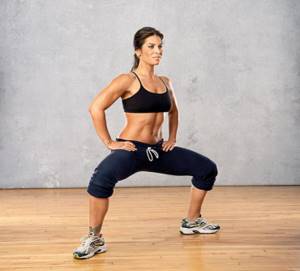
Wide deep squats are a calm stretching of the muscles of both thighs at the same time. You need to place your feet shoulder-width apart, bend your knees and lower your hips down. Place your palms in the solar plexus area, and your elbows between your knees.
The dumbbell shift exercise can also be done at home. Starting position – feet shoulder-width apart, body slightly tilted forward. Take the projectile with both hands and pull them down. Direct the projectile between your legs so that it is at knee level. On the bend, straighten up and return to the original position.
From a sitting position
Stretching in this pose includes the following types:
- "Happy child". This is an open, relaxing position in which all infants lie up to a certain age. To stretch the muscles, you need to lie on your back, bend your knees and grab your heels with your hands. Take five breaths, then lie in this position.
- Wide spread of legs to the sides. A great exercise to stretch your thigh muscles. You need to squat down and then lie down in this position. Place your feet on the floor. The heels should be further than the toes. Start to lower yourself onto your forearms, then onto your shoulders and bury your face in the mat, turning your head to the side.
- "Lizard". Widely used in yoga to stretch the outer thighs. Bend one leg and move the other back. Push your hands and pull your torso up. Perform the exercise 6 times.
- "Butterfly". The stretch is performed for both hips together. Sit on the mat, bend your knees, open your feet like a book. Straighten up and look ahead. Do 5 breathing exercises and bend over slowly.
- "Head to knee." With this exercise we stretch the back and leg muscles. Popular among track and field athletes. You need to sit down and straighten your legs. Bend your knee and bring your left foot toward your right hip. Then inhale and arch your upper chest. As you exhale, bend forward and try to touch your right foot with your fingers. Return to starting position.
- "Pigeon". An effective exercise for opening the hip joints, the technique of which is as follows:
- sit down on the mat, pull your left leg back, bend your right;
- Stretch your arms forward, placing your elbows on the floor;
- do the same for the other leg.
From a lying position
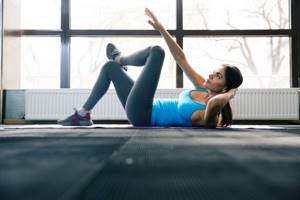
Muscle stretching is performed on a gymnastic mat. To do this, you should take a horizontal position, and raise your legs and move them in different directions and towards you. Knee bending exercises are done while lying on your back and stomach. The best option is to perform these muscle stretches with the help of a partner.
Hamstring exercises
Sit on the floor with your legs extended and spread apart. Turn your torso in one leg, grab your ankle with your hands and begin to slowly lean forward, trying to touch your knee with your forehead. You most likely won't succeed the first time. Do not despair. Bend as low as possible until the first feeling of discomfort and stay in this position for half a minute. Return to the starting position and repeat the bend on the other leg. Perform ten bends on each leg at a time.
Important! When bending over, try to stretch the muscles of the lower back, not the back, and keep your back straight (do not hunch). Gradually you will be able to bend lower and lower, and ideally you will easily lie with your stomach and chest on your leg, touching your forehead to your knee. By the way, this exercise helps get rid of belly fat.
Shoulder stretches
Place your hands behind your back, clasp your wrist with one hand and the other. Bend your elbows and lift your wrists higher. Push your chest forward and feel the stretch in the front of your shoulders.
Grab your opposite elbow with your hand, press your shoulder towards you and pull it down. Repeat with the other hand.
Grasp your right arm with your left above the elbow, press it to your body and straighten it, lower your right shoulder down. With your left hand, pull your right hand up, lifting it with your elbow. Feel the tension in the back of your shoulders.
Repeat with the other hand.
Go to the wall, lift your left elbow up, and place your forearm behind your back. Lower your left shoulder blade down. To check that it has actually dropped and will not rise during the stretch, place your right hand below your left armpit.
Repeat on the other side.
Grab a doorknob, counter, or other support and turn your back to it. Turn your elbow upward and move your body slightly forward.
Repeat with the other hand.
This pose allows you to simultaneously stretch the triceps of one arm and the front of the shoulder of the other. Place one hand behind your back from above so that your elbow points upward, and the other from below so that your elbow points to the floor. Try to bring your wrists together behind your back at the level of your shoulder blades.
Switch hands.
Sit on your knees, place your hands in front of you so that the backs of your hands touch the floor and your fingers point towards each other. Gently shift your weight into your hands, stretching your forearms. To enhance the effect, try clenching your fists.
Exercises for hips and buttocks
Lie on your back with your legs up and your knees bent at right angles. Place your right leg on your left knee, grab your left thigh (under the knee) with your hands and gently pull your leg towards you. Repeat the exercise for the other leg. Perform ten sets on each leg, making sure to keep your upper body relaxed.
There are different exercises for stretching the legs, and the complex offered to you includes only some of them. You can perform the entire complex or choose exercises for the most problematic areas. In any case, these exercises will restore elasticity to the leg muscles and lightness to the legs. Movements will no longer be constrained, and excess fat will gradually begin to “melt away.” So enjoy the exercises themselves and the results: with magical stretching this is possible. Good luck!
Exercises to stretch the outer thigh
Stretching your hip muscles will help keep your hips flexible, which is important for preventing injury.
- Sit on the floor with your legs as far apart as possible and in full contact with the floor.
- Keeping your back straight, lean forward at your hips.
- Hold for 10-30 seconds.
Muscles involved: Gracilis muscle. Major adductor. Long adductor.
In the video, the instructor shows how to correctly perform this exercise from the complex:
- Stand in front of a bench or high chair.
- Place your leg on the surface of the platform and bend it at the knee, pulling it under your stomach.
- Gradually lean forward, thus increasing the stretch.
- Perform 1 approach for 10-30 seconds.
Muscles involved: Gluteus maximus. Gluteus minimus. Gluteus medius. Pear-shaped.
The video shows how to perform this physical element:
- Stand with one leg extended behind the other.
- Bend to the side, but without stretching too much.
- Press into your thigh and push in the opposite direction.
- Perform the exercise for 10-30 seconds.
Alternatively, you can use a table. Place one foot on the table, stand sideways to it and bend as far as possible.
Muscles involved: Tensor fascia lata. Iliotibial tract. Sartorius.
This exercise can also be performed in a sitting position.
- To perform this exercise as a stretching complex for the tensor fascia lata, in a sitting position, you need to pull your knee across your body.
- Concentrate on your outer and inner thighs. If you feel pain, stop.
- Hold the pose for 20-30 seconds, rest and repeat 2-3 times.
⇒ See more stretching exercises here | Back stretching exercises
Lying stretch
Lie on the floor on your back, raise your knees bent. Place the ankle of your left foot on the knee of your right. Press the knee of your right leg onto your left to deepen the stretch. Repeat with the other leg.
Get on all fours, place your right ankle on your left knee. Push your pelvis back to deepen the stretch. Repeat with the other leg.
Stretching while sitting
Sit on the floor, stretch your legs forward, straighten your back. Bend one leg at the knee, grab your shin with your hands and press it to your chest. The shin should be parallel to the floor, the forearms lie on top and press it to the chest, one hand covers the other.
Repeat with the other leg.
Pigeon pose
Sit on the floor, bend one leg at the knee at a right angle and move it forward, take the other back and straighten it. You can lean forward and place your forearms on the floor.
If you have difficulty doing this pose on the floor, try placing your foot on an elevated platform.
Lie on the floor, leave one straight leg on the floor, raise the other. Place an expander, jump rope or rope over your foot and pull your leg towards you. Switch legs.
Stretching while standing
Stand up straight, take a step forward. Tilt your body almost parallel to the floor. If you leave the leg straight, the upper part of the back of the thigh is stretched more; if you slightly bend the leg at the knee, the lower part is stretched.
Tilt to feet
Sit on the floor, stretch your legs straight forward. Bend towards your feet and place your hands on either side of your feet or slightly further away. To deepen the stretch, you can straighten your back for a few seconds and then bend down again.
Sit on the floor, stretch one leg forward, bend the other at the knee and place your foot next to your pelvis. Bend towards your straight leg, grab your foot with your hands and pull the toe towards you. Try not to round your back.
Bend while standing
Spread your legs wider, toes pointing forward. Lower your body down, keeping your back straight, until you place your palms on the floor.
Split into a side split so that your iliac crests point forward. Place your palms on the floor and support your body weight on your hands. Try not to turn your hips and shoulders to the side.
Deep squat
Stand next to a rack or machine that you can hold on to. Feet shoulder-width apart, toes and knees turned outward. Lower yourself into a deep squat, keeping your back straight.
Butterfly near the wall
Sit on the floor with your back straight, fold your legs in front of you with your feet facing each other. Try to lower your knees to the floor, but do not put pressure on them with your hands. Keep your back straight.
Frog
Lie on the floor on your stomach, spread your knees to the sides and bend your legs at a right angle. Try to place your pelvis on the floor.
Lie on the floor on your stomach, spread your knees out to the sides so that your thighs are parallel to the floor. Bend one leg at the knee, straighten the other. Try to place your pelvis on the floor. Repeat with the other leg.
Forward fold
Sit on the floor, spread your straight legs wider, and then lean forward. Try to lie on your stomach on the floor, do not bend your knees.
Hip abduction
Stand next to a wall, turning your right side towards it. Place your right leg behind your left and squat down. The left leg bends, the right leg remains straight and moves further to the left. The straight body hangs over the left leg.
Repeat on the other side.
Stretching while standing
Place your left leg behind your right in front and lean to the left. You can place one hand on your belt, fold your arms above your head or in front of you. The more the body tilts, the better the muscles stretch.
How to relax tight thigh and quadriceps muscles? Five exercises
The hamstrings and quadriceps are some of the most difficult muscles to deal with post-workout pain. Most athletes involved in strength sports agree that these two muscle zones most often cause soreness, and the pain may not go away within a week. The reason for this is the low elasticity of these muscles, leading to their tightness.
We decided to help those who suffer from pain caused by tightness in the hamstrings and quadriceps muscles by talking about 5 life-saving exercises.
Double twist
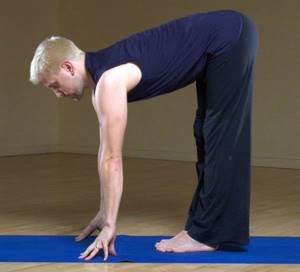
The exercise is performed standing and is aimed at relaxing and relieving pain in the back of the thigh.
.
A) You need to stand straight and then lean forward. The knees remain straight.
B) Stretch towards the floor at the toes of your feet, then move towards your knees.
Advice:
Be sure to keep your knees straight and your quadriceps tense.
Stretching the muscles of the hamstrings: standing
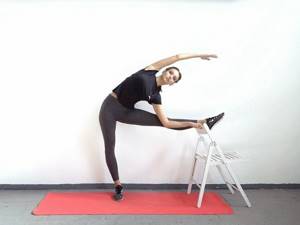
The exercise is aimed at relieving pain in the buttocks and back of the thighs
A) Place your foot on a bench or any other elevated surface
B) By tilting your body towards the foot of the leg located on the bench, reach for it.
C) Hold this position for 15-20 seconds, and then change your leg to the other.
Advice:
choose the right elevation - it should not be too high. Keep your knee straight, and you can move your pelvis slightly forward - this will enhance the effect of the stretch.
Stretching the thigh muscles. Pigeon
The “pigeon” exercise is one of the basic yoga poses. Allows you to effectively stretch your hips due to the fact that you can focus on working out the stretch for each hip.
- Sitting. The right knee is bent, the left leg is straight behind. Extend your right heel toward your left hip. Make sure your left thigh is always facing down towards the mat.
- Hands in front of you, elbows on the floor, allowing your torso to rest. Maintain the pose at the same time interval and repeat the exercise for the other thigh.
Stretching the quadriceps and hip flexors
The exercise is performed while standing on your knees.
A) Lowering yourself to the floor, place one leg in front of you, while bending it at the knee joint. Position the other leg so that its knee rests on the floor.
B) Now lift the leg lying behind you, taking it by the ankle, and pull it towards the buttock.
C) As soon as you feel that there is a stretch in the front surface of the thigh, stay in this position for 20-30 seconds. Then switch legs and repeat it all again.
Advice:
pull your leg towards the buttock slowly, avoiding sudden pain
Warm up before stretching
When you stretch after a workout, your muscles are already warmed up and no additional warm-up is required. If you decide to arrange a separate stretching lesson, first do a few exercises:
- Joint warm-up: twirl your joints, bend and twist your body.
- 5-7 minutes of cardio: running or Jumping Jacks, Rock Climber, running in place with high knees, jumping rope.
Once you've warmed up a bit, you can start stretching.
Lie on the floor on your stomach, lift one leg and place your hand on your ankle. Pull your leg towards your buttock, trying not to lift your thigh off the floor. Repeat with the other leg.
Get down on one knee, grab the toe of your back leg with your hand and pull your heel towards your buttock. Squeeze your gluteal muscles: this will deepen the stretch. Repeat with the other leg.
Get on one knee with both legs bent at a 90-degree angle. The back is straight. Tighten your gluteal muscles and move your pelvis slightly forward. You should feel tension in the front of your back leg and in your groin.
Switch legs.
Deep Lunge
Take a deep lunge forward. Place your fingers on the floor on either side of your foot. Lower the knee of the straightened leg to the floor. Try to go lower and do not turn your pelvis to the side.
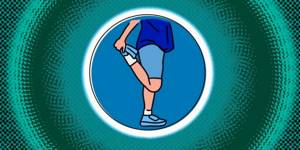
Switch legs.
Standing quadriceps stretch
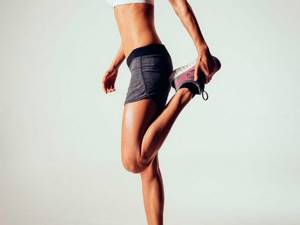
A) Standing up straight, grab your foot.
B) Then, bending your knee, pull your heel towards your buttock.
Advice
: If you can't balance, hold on to a wall/chair. When performing the exercise, make sure that your knee points to the floor and your leg does not deviate to the side.
The main thing in performing the above exercises is the smoothness of their execution. Repeat each 3 to 5 times, this is guaranteed to help relax the muscles and ligaments. Trust your feelings - as soon as you feel that the muscles are stretched enough, stop to avoid the effect of overstretching.


